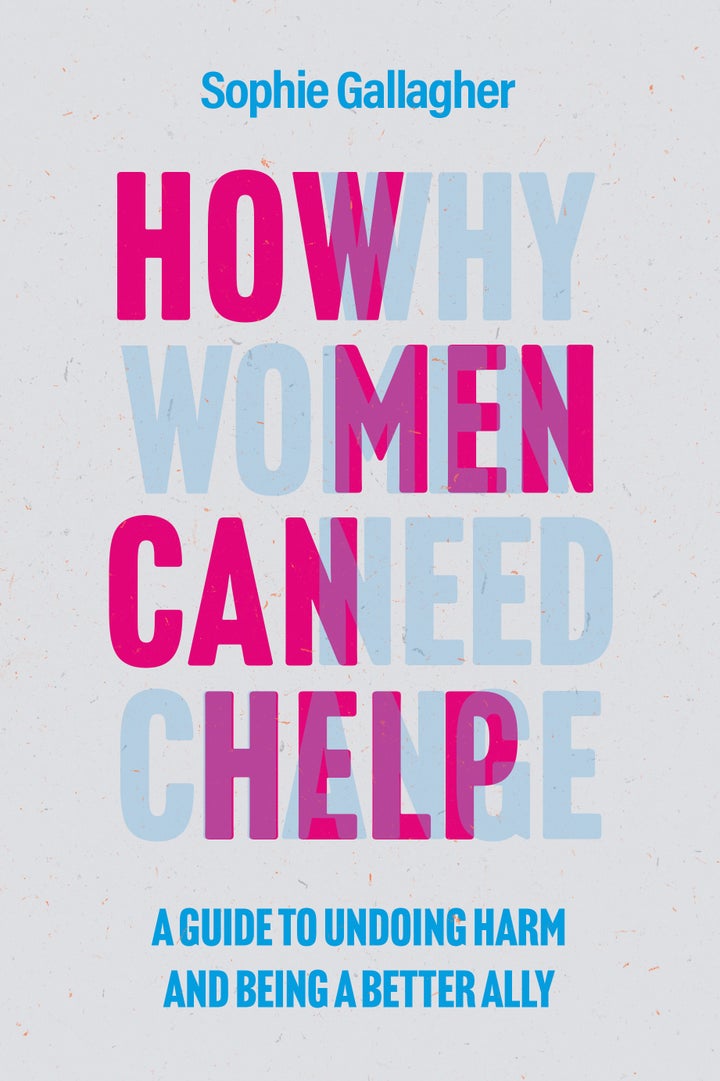
Women know all too well the intricacies of gender-based violence – from its inception, its causes, how it impacts them, and how even non-physical violent sexual discrimination and harassment can leave you traumatised.
The latter is something author and journalist Sophie Gallagher, 31, from London, can relate to.
In her debut book How Men Can Help, she begins recounting the traumatising experience of being a teenager, walking down a street with a friend.
At 17 years old, Gallagher and a school friend took a short route back home following a gig, but a man followed them, until they had no choice but to run.
The experience, one that’s likely to be shared by many women and girls, stayed with the author, and in her book she implores men in no uncertain terms to do the work to stop instances like this from happening.
She tells HuffPost UK why she wrote the book: “Every time there is another woman killed on our streets, we have the same cyclical response. First come the angry headlines, then the tragic vigils, and finally the advice for women about what to do now – to stay alert, to take out their headphones when walking, or stick together in groups, to change their route home or to grab a taxi.
“And if a woman did all the ‘right things’ and still was a victim of violence, we concede that she was just unlucky, ‘she was just walking home’ we tell ourselves.”

The book could not be more timely, in a landscape where women’s safety has been pushed to the top of the news agenda following the murders of Sarah Everard, Bibaa Henry and Nicole Smallman, Sabina Nessa, Ashling Murphy and many others.
Of course, the onus is on perpetrators to stop committing these crimes. But what are we, as a society, getting wrong when it comes to making women feel safe and tackling the wider, systemic imbalance?
“At no point do we ever start telling men how to behave,” says Gallagher. “There is never a question of asking men to change, or looking at the root cause of this violence rather than just accepting it as an inevitability that women have to learn to avoid. Women must always be smarter, be more strategic, and be more careful. ”
The same conversation may be happening because men don’t feel part of it, which is why Gallagher elaborates just exactly how they can. Here are a few of the ways (most) guys are currently missing the mark – and what you can all do to help.
Whose onus is it anyway?
With the word ‘women and girls’ in gender-based violence, many just think it’s a female issue. But with the majority of perpetrators being men, it’s hard to ignore male involvement, therefore making it an issue for everyone.
Gallagher says: “The biggest thing we’ve been getting wrong is assuming that women are the ones to solve this problem – we must see that women are the collateral damage of a problem that does not start with them. Gender-based violence is primarily committed by men – nine out of 10 murders (of both men and women) are done by men, according to a 10-year analysis by the University of Gothenberg in Sweden.
“When it comes to sexual violence in England and Wales, 98.3% of rapists (of both men and women) are men. And 92% of domestic abuse defendants in the year to March 2020 were men. This is a gendered problem that can only be solved by getting most men on board and having men understand they need to help.”
Not all men are violent. But all men can help
Starting a conversation about gendered-based violence often sparks protestations of “not all men!” – but all men can help.
“One of the biggest barriers to this has always been that men who do not commit violence against women do not see a role for themselves in this – they see their own ‘good’ behaviour as enough,” says the author.

Gallagher draws similarities between race and gender, and how even ‘good’ people can heighten the problem of racism by doing nothing.
“We need all men to take up this baton, in the same way that not being racist yourself is not enough to avoid doing anti-racist work. To be an ally you must step up, rather than just sit on the sidelines feeling content with your contributions,” she says.
“The ways that men can begin to fix this issue are, unfortunately, not a simple tick list of things to do on a Saturday morning and be finished with. But they begin with seeing the scale of this problem, seeing how widely it affects the women around you, listening to women’s stories and experiences, and understanding that just because you might not see the violence, it doesn’t mean it isn’t happening.”
Not understanding that loved ones can be perpetrators
Like the idea that only bad men commit sexual crime and deviancy, many think it’s only strangers lurking in dark alleyways that contribute to the problem, when the opposite tends to be true for many women.
“Men need to be wary of the ‘monster myth’ that violence only happens on the fringes of society, with people we don’t know and do not associate with,” says Gallagher.
“When in actuality, according to the ONS data, 44% of rapes are committed by partners and ex-partners.”
Not understanding that sexism sits on a spectrum
Smaller acts of harassment – fixed stares on public transport, cat-calling, asking women to ‘smile’ and ‘cheer up’ – can eventually end in much larger and damaging acts of assault. Take, for instance, the fact that a third of those charged with upskirting, which became illegal in 2019, were guilty of other sexual offences including child abuse and sexual assault.
But even in isolation, those seemingly ‘smaller’ acts are damaging.
Gallagher says: “Men need to be prepared to look at the ways inequality penetrates through all areas of society – the most extreme violence is just one end of a spectrum that includes all manner of ways of making women secondary: sexism in the workplace, sexist remarks in the pub, presumptions of women giving up their careers for children or being paid less, taking the word of a man over a woman because you implicitly trust men more.
“We can all do work to get our own houses in order when it comes to violence against women and girls.”
Being desensitised from the issue
To a degree, we are all desensitised from these issues, says the writer, because it is startling to see how frequently violence against women happens.
“Men genuinely do not see or hear how common this is,” she argues. “They believe it is something that only happens in headlines and newspapers to women they do not know, or women elsewhere, rather than being chronically widespread. This can be described as a form of male blindness.”
She cites research by Police Scotland in 2021 which found men are still widely off the mark when it comes to understanding how women experience harassment. Three quarters of women said groping or grabbing was a regular experience for them, but only a quarter of men thought it was common. Only half of men thought cat-calling was frequent, but three quarters of women said it was.
Gallagher concludes: “We need this book because this narrative has to change. How can women be both burdened with suffering under gender-based violence, and coming up with the solution too? This is frankly not women’s problem to solve.”
Amen.